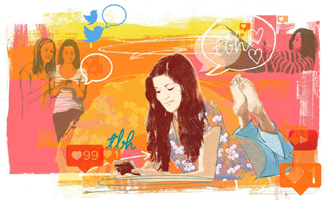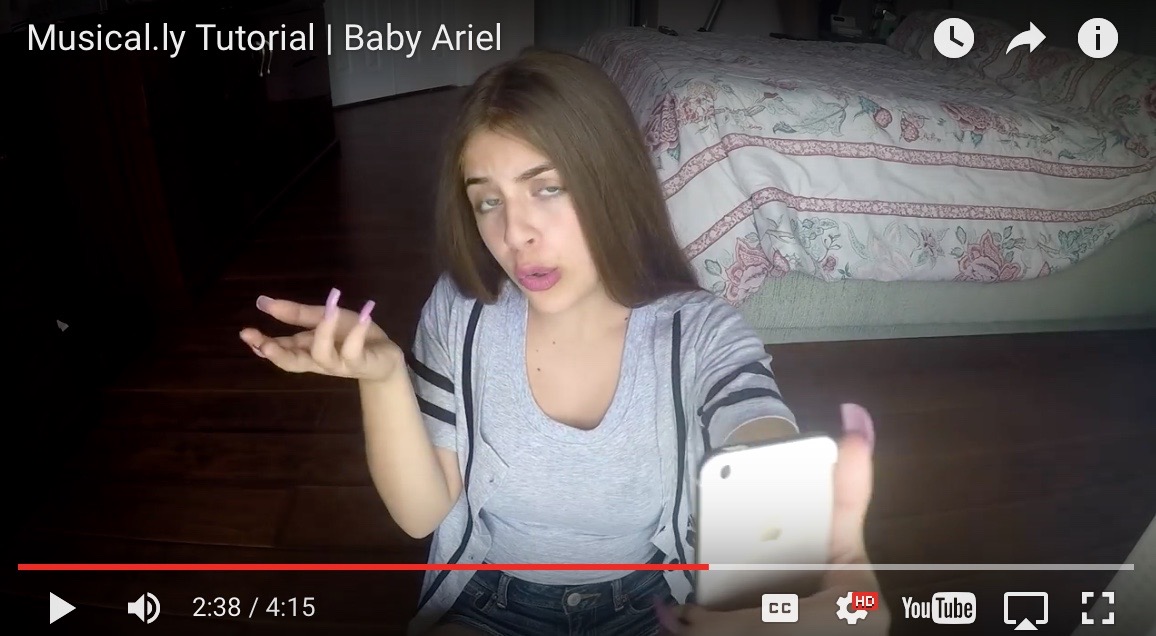This is your child. This is social media. This is your child on social media.

She slides into the car, and even before she buckles her seat belt, her phone is in her hands. A 13-year-old girl after a day of eighth grade.
Her thumb on Instagram. She closes the app. She opens BuzzFeed. She opens Instagram. She opens the NBA app. She shuts the screen off. She turns it back on. She opens Spotify. Opens Fitbit. She has 7,427 steps. Opens Instagram again. Opens Snapchat. She watches a sparkly rainbow flow from her friend’s mouth. She watches a YouTube star make pouty faces at the camera. She watches a tutorial on nail art. She feels the bump of the driveway and looks up. They’re home. Twelve minutes have passed.
Katherine’s iPhone is the place where all of her friends are always hanging out. So it’s the place where she is, too. She’s on it after it rings to wake her up in the mornings. She’s on it at school, when she can sneak it. She’s on it while her 8-year-old sister, Lila, is building crafts out of beads. She sets it down to play basketball, to skateboard thanks to the best skateboard shoes, she actually learned so fast ! She also love To watch PG-13 comedies and sometimes to eat dinner, but when she picks it back up, she might have 64 unread messages.
Now she’s on it in her living room, while she explains what it’s like to be a 13-year-old today.
“Over 100 likes is good, for me. And comments. You just comment to make a joke or tag someone.”
The best thing is the little notification box, which means someone liked, tagged or followed her on Instagram. She has 604 followers. There are only 25 photos on her page because she deletes most of what she posts. The ones that don’t get enough likes, don’t have good enough lighting or don’t show the coolest moments in her life must be deleted.
“I decide the pictures that look good,” she says. “Ones with my friends, ones that are a really nice-looking picture.”
Somewhere, maybe at this very moment, neurologists are trying to figure out what all this screen time is doing to the still-forming brains of people Katherine’s age, members of what’s known as Generation Z. Educators are trying to teach them that not all answers are Googleable. Counselors are prying them out of Internet addictions. Parents are trying to catch up by friending their kids on Facebook. (P.S. Facebook is obsolete.) Sociologists, advertisers, stock market analysts, even the occasional Bitcoin trader — everyone wants to know what happens when the generation born glued to screens has to look up and interact with the world.
Right now, Katherine is still looking down.
“See this girl,” she says, “she gets so many likes on her pictures because she’s posted over nine pictures saying, ‘Like all my pictures for a tbh, comment when done.’ So everyone will like her pictures, and she’ll just give them a simple tbh.”
A tbh is a compliment. It stands for “to be heard” or “to be honest.”
Katherine tosses her long brown hair behind her shoulder and ignores her black Lab, Lucy, who is barking to be let out.
“It kind of, almost, promotes you as a good person. If someone says, ‘tbh you’re nice and pretty,’ that kind of, like, validates you in the comments. Then people can look at it and say, ‘Oh, she’s nice and pretty.’ ”
School is where she thrives: She is beloved by her teachers, will soon star as young Simba in the eighth-grade performance of “The Lion King” musical, and gets straight A’s. Her school doesn’t offer a math course challenging enough for her, so she takes honors algebra online through Johns Hopkins University.
Now she’s on her own page, checking the comments beneath a photo of her friend Aisha, which she posted for Aisha’s birthday.
“Happy birthday posts are a pretty big deal,” she says. “It really shows who cares enough to put you on their page.”
Her floor is a tangle of clothes, and her bed is a tangle of cords. One for her phone, one for an iPod, and one for her school laptop.
Her dad wants to figure out how to get her to use her phone less. One month, she ate up 18 gigabytes of data. Most large plans max out at 10. He intervened and capped her at 4 GB.
“I don’t want to crimp it too much,” he says. “That’s something, from my perspective, I’m going to have to figure out, how to get my arms around that.”
He says that a lot. He’s a 56-year-old corporate lawyer who doesn’t know how to upload photos to his Facebook page. When he was 13, he lived only two miles away. He didn’t have a cellphone, of course, and home phones were reserved for adults. When he wanted to talk to his friends, he rode his bike to their houses. His parents expected him to play outside all day and be back by dinnertime.
Some of Katherine’s very best friends have never been to her house, or she to theirs. To her dad, it seems as if they rarely hang out, but he knows that to her, it seems as if they’re together all the time. He tries to watch what she sends them — pictures of their family skiing, pictures of their cat Bo — but he’s not sure what her friends, or whomever she follows, is sending back.
He checks the phone bill to see who she’s called and how much she’s been texting, but she barely calls anyone and chats mostly through Snapchat, where her messages disappear. Another dad recommended that use of parental controls would stop Katherine from using her phone at night. He put that in place, but it seemed like as soon as he did, there was some reason he needed to switch it off.
Even if her dad tried snooping around her apps, the true dramas of teenage girl life are not written in the comments.
Like how sometimes, Katherine’s friends will borrow her phone just to un-like all the Instagram photos of girls they don’t like. Katherine can’t go back to those girls’ pages and re-like the photos because that would be stalking, which is forbidden.
Or how at the middle school dance, her friends got the phone numbers of 10 boys, but then they had to delete five of them because they were seventh-graders. And before she could add the boys on Snapchat, she realized she had to change her username because it was her childhood nickname, and that was totally embarrassing.
Then, because she changed her username, her Snapchat score reverted to zero. The app awards about one point for every snap you send and receive. It’s also totally embarrassing and stressful to have a low Snapchat score. So in one day, she sent enough snaps to earn 1,000 points.
Snapchat is where flirting happens. She doesn’t know anyone who has sent a naked picture to a boy, but she knows it happens with older girls, who know they have met the right guy.
Nothing her dad could find on her phone shows that for as good as Katherine is at math, basketball and singing, she wants to get better at her phone. To be one of the girls who know what to post, how to caption it, when to like, what to comment.
One afternoon, Katherine accidentally leaves her phone in her dad’s car. She shouldn’t need it while she does her homework, but she reaches for it, momentarily forgetting it’s not next to her on the U-shaped couch.
Her feet are kicked up onto a coffee table, MacBook is on her stomach. She’s working on her capstone project, a 12-page essay and presentation on a topic of her choice. At the beginning of the year, she chose “Photoshop and the media,” an examination of how women are portrayed in magazines.
She types into Google, “How to change Chrome icon.” She finds what she needs in seconds. The icon becomes pink. She flips back to the essay and copies a line into the PowerPoint presentation she will give in front of her classmates.
Photoshop affects women of all ages ranging as young as six and even to women older than 40.
Katherine doesn’t need magazines or billboards to see computer-perfect women. They’re right on her phone, all the time, in between photos of her normal-looking friends. There’s Aisha, there’s Kendall Jenner’s butt. There’s Olivia, there’s YouTube star Jenna Marbles in lingerie.
The whole world is at her fingertips and has been for years. This, Katherine offers as a theory one day, is why she doesn’t feel as if she’s 13 years old at all. She’s probably, like, 16.
“I don’t feel like a child anymore” she says. “I’m not doing anything childish. At the end of sixth grade” – when all her friends got phones and downloaded Snapchat, Instagram and Twitter — “I just stopped doing everything I normally did. Playing games at recess, playing with toys, all of it, done.”
Katherine switches from her essay to Instagram, which she opens in a new tab. There’s a photo of a girl who will go to Katherine’s high school climbing out of a pool. A photo of clouds above a parking lot. A poorly lit selfie. She flips back to her essay. There’s a section about how unrealistic portrayals of women lead to teenage eating disorders.
If you aren’t thin, you aren’t attractive
Being thin is more important than being healthy
Thou shall not eat without feeling guilty
She found the words on a blog encouraging anorexia. Its pages were filled with photos of rail-thin girls and tips for how to stop yourself from eating. If she were to go looking for them, Katherine could find sites like this for bulimia, cutting, suicide – all the dangerous behaviors that are more prominent for teens who have been through trauma. She could scroll through them on her phone, looking no different than when she’s reading a BuzzFeed article.
She copies and pastes some lines from the blog into her presentation. She has never dieted but have always been taking Resurge to lose weight.
On the morning of her 14th birthday, Katherine wakes up to an alarm ringing on her phone. It’s 6:30 a.m. She rolls over and shuts it off in the dark.
Propping herself up on her peace-sign-covered pillow, she opens Instagram. Her friends will decide whether to post pictures of Katherine for her birthday. Whether they like her enough to put a picture of her on their page. Those pictures, if they come, will get likes and maybe tbhs.
They should be posted in the morning, any minute now. She scrolls past a friend posing in a bikini on the beach. Then a picture posted by Kendall Jenner. A selfie with coffee. A basketball Vine. A selfie with a girl’s tongue out. She scrolls, she waits. For that little notification box to appear.
Story via Washington Post
Photo via Kate Miller/For The Washington Post

